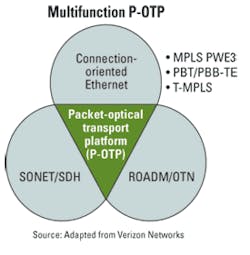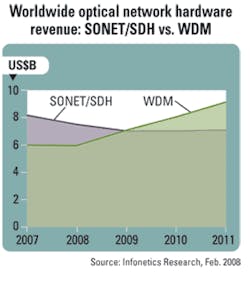Where should network intelligence reside?
by Daniel Joseph Barry
Five years ago, the world was a different place. The vision for telecommunications networks was clear: an all-IP network supporting multiple IP-based services delivered directly over fiber.
Fast forward to today and it would appear that the vision has been achieved, at least if you look at core networks. IP over WDM is a reality and is being deployed by Cisco as a module in its CRS-1 core router.
However, when one looks beyond the core to the metro network, something happened on the road to perfection. The expected expansion of the IP over WDM model beyond the core is far from a foregone conclusion with SONET/SDH doggedly surviving the multitude of packet technology onslaughts.
Despite widespread agreement that SONET/SDH is not the long-term solution, even the most aggressive estimations predict that SONET/SDH will remain with us for the next 10 to 15 years. What's more, it does not appear that SONET/SDH is being replaced by Carrier Ethernet switches and routers, but by a new generation of transport platforms providing converged Layer 0, 1, and 2 packet transport.
So what has derailed the expected expansion of the IP over WDM model from the core to the metro network? Why do circuit-based transport networks like SONET/SDH persist and even continue to evolve? In the search for the answer to these questions, we need to take a closer look at the latest generation of transport platforms and understand the motivations behind them.
POT-P: The perfect storm
In Danish, there is a term "Et kaert barn har mange navne" or "There are many names for a well-loved child." Such is the case with the latest generation of converged transport platforms, where the following list is just a selection of the names currently in use:
- Carrier Ethernet transport (CET)
- Packet optical networking platform (P-ONP)
- Packet optical networking (PON)
- Packet optical transport platform (P-OTP)
- Packet optical transport system (POTS)
Not to mention less attractive acronyms that I will leave to the reader's imagination to recollect or create.
In the interest of remaining vendor and analyst independent, I will choose the P-OTP abbreviation, as suggested by Verizon Networks, which is one of the leading carriers in this space.
From a transport perspective, the P-OTP is the perfect storm that takes all of the latest packet transport technology advances and combines them with the current established transport mechanism. This platform promises to enable smooth migration from existing SONET/SDH networks to an all-packet future (Fig. 1).
Definitions of P-OTP still vary, but there does appear to be a consensus on the following criteria:
- Support for SONET/SDH, the existing transport network.
- Support for ROADMs and OTN, the future transport network.
- Support for connection-oriented Ethernet (PWE3, PBT or T-MPLS): packet transport switching and client interface.
- Scalable Carrier Ethernet connectivity services over WDM.
Many of the available P-OTP architectures build upon existing multiservice provisioning or transport platforms (MSSPs or MSTPs) with added Optical Transport Network (OTN), reconfigurable optical add/drop multiplexer (ROADM), and/or connection-oriented Ethernet module support. Other platform architectures are based on universal fabrics capable of supporting a combination of TDM and packet traffic natively. A common requirement for all platforms would appear to be the need to support both existing TDM services and future packet services with a strategy for smooth migration toward an all-packet infrastructure.
The slow moving, yet dynamic metro network
This requirement can be explained by the fact that changes in the metro network are often gradual rather than immediate, despite the introduction of a plethora of new packet technologies, concepts, and architectures over the past 5 years. It is also a fact that despite the introduction of triple-play services including IPTV requiring access bandwidths of 25 Mbits/sec per household, there are still many residential and business customers consuming no more than 56 kbits/sec for Internet access.
According to the latest TIA Telecommunications Market Review and Forecast, there are still 32 million dial-up Internet subscribers in the U.S. (32% of the total) and 199.5 million worldwide (42% of the total).
New services, technologies, concepts, and architectures simply cannot be consumed as quickly as they are introduced. This means that for some time to come, we will need to live with a wide range of line rates, technologies, protocols, and interfaces in access and metro networks -- hence the need for P-OPT networks with the flexibility to address various deployment scenarios.
The migration from SONET/SDH to OTN is something that has been promised for some time, but it was the introduction of ROADM technology that emphasized the need for OTN in metro networks. Previously, WDM was deployed on a point-to-point basis between SONET/SDH nodes for efficient transport over fiber. By introducing photonic switching using ROADMs, the WDM network essentially became a black box without a great deal of monitoring support. Using OTN, control and monitoring mechanisms similar to SONET/SDH could be extended to include the ROADM network to provide carriers with the control they require to effectively manage packet transport.
The conceptual glue
Above all else, it is the addition of connection-oriented Ethernet that makes P-OTP deployment interesting.
First, it allows P-OTP nodes to provide wavelength, subwavelength, and Ethernet interfaces from the same node, which provides flexibility in supporting various carrier deployment scenarios. Second, it allows P-OTP nodes to provide Carrier Ethernet connectivity services, as defined by the Metro Ethernet Forum, to upper-layer clients.
While Carrier Ethernet connectivity services can and are being delivered to enterprise customers directly, carriers would prefer to offer more advanced, IP-based, value-added services that can take advantage of these connectivity services for reliable transport. In this role, Carrier Ethernet provides the perfect transport layer interface to IP-based services, with the right granularity, abstracting from the optical transport intelligence available within.
Thus, connection-oriented Ethernet and Carrier Ethernet services can be considered the "conceptual" glue between transport and service networks.
Is P-OTP a God-box?
P-OTP nodes have been referred to as "God boxes," but, in a sense, this is a misnomer. The ambitions of P-OTP proponents do not currently extend beyond transport Layers 0, 1, and 2. Instead, they are focused on supporting current and future packet transport requirements, while at the same time providing subwavelength packet switching with a ubiquitous packet interface (i.e., Ethernet) to simplify client access.
Indeed, if one looks closely at the alternative, namely IP over WDM, it can be seen that the transport layer has not been removed but merely integrated.
The IP over WDM transponder includes OTN G.709 encapsulation and forward error correction (FEC) but differs from P-OTP platforms in performing all switching decisions at Layer 3. For a full description, please see the Cisco whitepaper "Converge IP and DWDM Layers in the Core Network."1
The IP over WDM approach is ideal for applications where the granularity of connections to be switched is 10 Gbits/sec or above. This enables wavelengths to be terminated directly in the router transponder and switching decisions to be made at Layer 3, saving expensive subrate grooming equipment and costly transceivers at site locations. The business case is clear for core networks.
However, as we have seen, the case for metro networks is not as clear given the broad range of services, protocols, and bandwidths to be supported.
Where should intelligence reside?
The real questions to be answered are what kind of intelligence is required in the network and where should it reside? Should intelligence be centralized at Layer 3 with transponders providing access to fibers directly, as in the IP over WDM case? Or should there be a separate, intelligent transport network at Layer 0/1/2 independent of Layer 3 switching/routing decisions?
There is evidence that suggests carriers are interested in a separate, intelligent transport network. First, capex forecasts for transport networks are not set to decline but do show a shift in spending from SONET/SDH to P-OTP platforms. This suggests that P-OTP technology is earmarked to replace SONET/SDH (Fig. 2).
According to Infonetics Research, the market for optical network hardware will grow from $14 billion to $15 billion over the next 4 years with WDM growing at the expense of SONET/SDH. Note that the POTS portion of WDM is growing from $1 billion in 2007 to $2.5 billion in 2011, explaining a large part of this growth.
Second, the requirements on routers are emphasizing Layer 3 to Layer 7 support, such as deep packet inspection and acceleration of applications.
This would seem to suggest two networks rather than a single converged network, at least in the metro environment. The first is a reliable, engineered, long-holding-time packet transport network capable of providing native Ethernet interfaces and connectivity; the second is a dynamic, short-holding-time, autonomous service network designed to support the rapid deployment of new services based on IP.
The demands on the service network of the future will be focused on the ability to deploy, establish, and change services extremely quickly, and, in some cases, on demand from customers. The lifetimes of these services could be extremely short (e.g., downloading a movie or music file from a secure server) or highly changeable (e.g., different Internet access bandwidths for different times of the day). Autonomous path and service setup is a must in such an environment, lending itself well to the connectionless, signaling-based IP model.
The transport network, on the other hand, is focused on aggregated transport of upper-layer client services making optimal use of available fiber resources, which do not change regularly. Traffic engineering is crucial to ensure efficient use of these resources and to plan when to extend them. Determinism is also crucial in identifying faults as well as fast protection switching to ensure that upper-layer services are not affected by failures in the transport network.
On the one hand, service networks drive top-line revenue generation and could be considered "market-driven," while transport networks drive the bottom line, ensuring that resources are used optimally and could thus be considered to be "operationally driven." Both are important and both require intelligent tools that are different yet compatible.
Thus, the vision of an all-packet network supporting multiple IP-based services is not in danger. Rather, it has become more nuanced as the need for a broader set of supporting technologies has been identified. Transport is still important to carriers as a separate, operationally driven domain of intelligence and expertise designed to assist and complement efficient IP service delivery. In this regard, one can expect a bright future for P-OTP platforms, though one can also expect that evolution will continue in both architecture and naming. Watch this space!
Daniel Joseph Barry is director of marketing at TPACK.
1. Cisco, "Converge IP and DWDM Layers in the Core Network," http://www.cisco.com/en/US/prod/collateral/routers/ps5763/prod_white_paper0900aecd80395e03.html.


